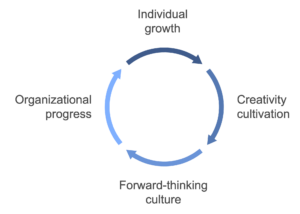The move to product teams is a reimagining of how IT delivers value. CIOs are pushing towards product management because it zeroes in on business outcomes, which is exactly where the focus should be. Restructuring IT operations around product teams lets organizations create a direct alignment between technology and business goals.
Here’s some food for thought: 87% of organizations using product teams are already leveraging this model to meet business objectives. The top 20% of these high-performing organizations are 3.2 times more likely to measure success by business outcomes. Think about that—3.2 times more likely to hit the targets that matter most. That’s a major efficiency boost.
This isn’t plug-and-play though. It takes cultural shifts, leadership that gets it, and reworked processes to make this model work well in the real world. You’re essentially rewiring the way your company thinks and operates.
The beauty of product teams is how they bring focus. IT won’t be chasing after vague deliverables anymore. They’re tied directly to what moves the needle for the business, with every component, every decision, every sprint calibrated for top performance.
How CIOs can steer a clean shift to product-based IT
Transitioning to product-based IT needs meticulous planning, smart execution, and phased scaling. Start small with pilot projects. These test runs let you iron out the kinks before rolling out the model across your IT operations. The data backs supports this too: currently, 38% of IT work follows the product-based model. Within five years, CIOs predict this will jump to 70%.
The real opportunity here is speed. Shifting more of your operations to product-based delivery lets your organization react faster, build smarter, and stay ahead of the competition. The next five years will be about a full-scale transformation that positions your business as a leader.
Remember, the goal here isn’t only to shift how IT operates, it’s to make your entire organization more agile and aligned. If done right, this transition can be a launchpad for sustained growth.
Turn middle managers into change leaders
For a product-based model to succeed, they need to evolve from task managers to people developers. Think coaching, mentoring, and driving innovation. About 38% of CIOs who’ve made the leap say middle managers’ roles have been completely redefined.

The innovation cycle through coaching and mentoring
It’s not enough to expect them to adapt on their own. Organizations need to invest in their learning and development. Equip them with the skills they need to manage performance in this new model, and they’ll drive exponential value.
Assign middle managers to lead centers of excellence or communities of practice. This gives them ownership of critical initiatives and fosters collaboration across teams. The result? A pipeline of leadership that’s future-ready. Without this evolution, middle managers can become bottlenecks. With the right support, though, they’ll be the change agents needed to make the product-based model successful.
Start by address these obstacles to product-based success
A surprising 65% of CIOs point to business culture as a major challenge. 53% also struggle with outdated funding models that cling to project-centric thinking. Add in teams that aren’t fully ready to self-organize, and you’ve got a trifecta of challenges.
Changing culture takes grit and persistence. CIOs need to remap processes, rethink systems, and model behaviors that align with the new way of working. Dealing with funding is another major challenge—but an important one—as moving away from project-based budgets to funding products over their lifecycle is key for true alignment.




